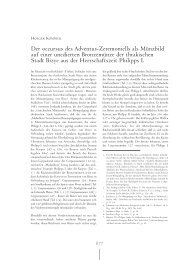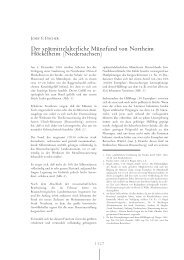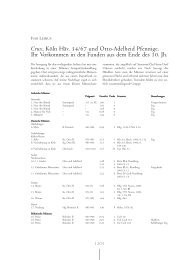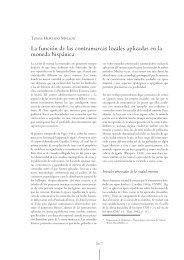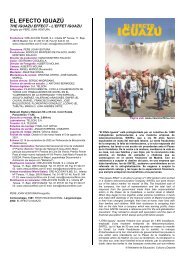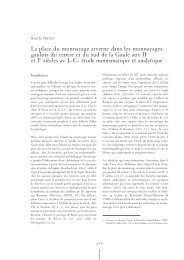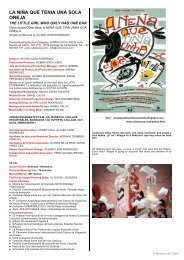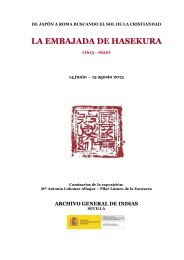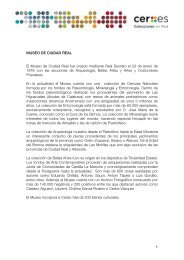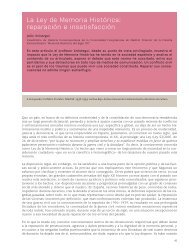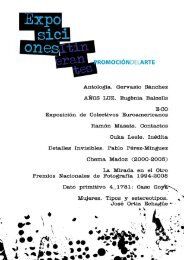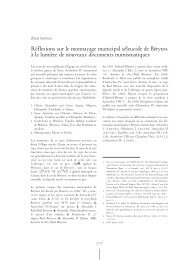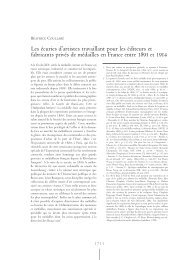Monete e insegne del potere: la raffigurazione di elmi fra IV e VI ...
Monete e insegne del potere: la raffigurazione di elmi fra IV e VI ...
Monete e insegne del potere: la raffigurazione di elmi fra IV e VI ...
You also want an ePaper? Increase the reach of your titles
YUMPU automatically turns print PDFs into web optimized ePapers that Google loves.
Le ricerche degli ultimi decenni hanno portato ad una<br />
migliore definizione tipologica e cronologica <strong>di</strong> questi<br />
ultimi, che, come già rilevato dall’Alföl<strong>di</strong>, presentano una<br />
parente<strong>la</strong> con quelli raffigurati su monete sassani<strong>di</strong> 26 e<br />
con <strong>elmi</strong> simili a quello rinvenuto a Dura Europos 27 .<br />
L’esistenza <strong>di</strong> caschi protostorici italiani e alpini analogamente<br />
strutturati 28 suggerisce, però, come tale soluzione<br />
formale possa essere stata in<strong>di</strong>viduata in ambiti <strong>di</strong>versi in<br />
momenti <strong>di</strong>fferenti per rispondere a problemi simili,<br />
senza alcun rapporto <strong>di</strong>retto <strong>di</strong> <strong>di</strong>pendenza 29 .<br />
Prima <strong>di</strong> procedere nell’analisi <strong>del</strong>le raffigurazioni monetali,<br />
credo sia opportuno ricordare brevemente le<br />
principali caratteristiche degli <strong>elmi</strong> ad arco, che per il<br />
rivestimento in <strong>la</strong>mine d’argento, spesso dorate, e talvolta<br />
decorate dall’inserzione <strong>di</strong> paste vitree imitanti pietre<br />
preziose 30 , si configurano come un copricapo partico<strong>la</strong>rmente<br />
lussuoso. La calotta, composita, è resa coerente da<br />
una fascia trasversale che ha anche <strong>la</strong> funzione <strong>di</strong> cresta.<br />
La presenza o l’assenza <strong>di</strong> una fascia frontale che raccorda<br />
<strong>la</strong> calotta con paranuca, paragnati<strong>di</strong> e paranaso<br />
consente <strong>di</strong> <strong>di</strong>stinguere gli <strong>elmi</strong> ad arco in due gran<strong>di</strong><br />
gruppi, uno, con tale elemento, attribuito al<strong>la</strong> cavalleria<br />
(fig. 17 a-f) e l’altro, che ne è privo, assegnato al<strong>la</strong> fanteria<br />
(fig. 17 g-q). Questi ultimi erano caratterizzati<br />
dal<strong>la</strong> presenza costante <strong>di</strong> un’apertura, per <strong>la</strong>sciare scoperte<br />
le orecchie, che può interessare sia <strong>la</strong> calotta che le<br />
paragnati<strong>di</strong> e che in un caso (Berkasovo 2, fig. 17 c) ricorre<br />
però anche in un esemp<strong>la</strong>re da cavalleria.<br />
L’introduzione <strong>di</strong> questi caschi nell’armamento militare<br />
romano sembra da porre negli ultimi decenni <strong>del</strong> III<br />
secolo 31 . Il termine cronologico più basso per il loro<br />
utilizzo è costituito dal rinvenimento <strong>di</strong> un elmo<br />
tipologicamente affine nel<strong>la</strong> tomba unna <strong>di</strong> Concesti,<br />
datata agli inizi <strong>del</strong> V secolo 32 (fig. 17f).<br />
L’analisi <strong>del</strong>le poche raffigurazioni <strong>di</strong> questi copricapi<br />
33 , come pure <strong>la</strong> loro preziosità, induce a ritenere che<br />
si tratti <strong>di</strong> <strong>elmi</strong> destinati a corpi scelti 34 come gli<br />
Stablesiani 35 e <strong>la</strong> guar<strong>di</strong>a personale <strong>del</strong>l’imperatore 36 ,<br />
forse indossati non solo durante cerimonie ma anche<br />
in battaglia 37 .<br />
Torniamo ora al<strong>la</strong> monetazione <strong>di</strong> Costantino. Essa presenta<br />
quattro tipi <strong>di</strong>fferenti <strong>di</strong> elmo ad arco, uno da<br />
fanteria e tre da cavalleria, che trovano riscontro in caschi<br />
noti archeologicamente, anche se nelle raffigurazioni<br />
monetali sono omessi il paranuca e il paranaso, mentre le<br />
paragnati<strong>di</strong> vengono normalmente raffigurate riducendone<br />
<strong>di</strong>mensioni e importanza e alterandone <strong>la</strong> forma.<br />
MONETE E INSEGNE DEL POTERE: LA RAFFIGURAZIONE DI ELMI FRA <strong>IV</strong> E <strong>VI</strong> SECOLO D.C.<br />
749<br />
26. Va, però, ricordato che tali emissioni si interruppero circa un secolo<br />
prima <strong>di</strong> quelle costantiniana: Bastien 1992-1994, p. 213 e<br />
Bianchi in Lusuar<strong>di</strong>, Perassi, Facchinetti, Bianchi 2002, p. 40-41.<br />
27. James, S.: Evidence from Dura Europos for the Origins of the Late<br />
Roman Helmets, Syria, 63, 1986, p. 107-134; Bianchi in Lusuar<strong>di</strong>,<br />
Perassi, Facchinetti, Bianchi 2002, p. 42.<br />
28. Egg, M.: Italische Helme. Stu<strong>di</strong>en zu den ältereisenzeitlischen Helmen italiens<br />
und der Alpen, Mainz 1986, p. 23-40 e 154-188.<br />
29. Contrariamente a D. Studer (Frügeschichtliche Kammhelme aus<br />
dem Kanton Tessin und dem weiteren südosteuropäischen Raum –<br />
ein Faktor bei der Entiwicklung des spätrömischen Kammhelms?,<br />
HelvetArch, 21, 1990, p. 82-126) non ritengo verosimile ipotizzare<br />
una derivazione <strong>di</strong>retta degli <strong>elmi</strong> ad arco da quelli protostorici<br />
a motivo <strong>del</strong>l’ampio arco cronologico che separa queste due tipologie<br />
<strong>di</strong> manufatti.<br />
30. Recano questo tipo <strong>di</strong> decorazione gli <strong>elmi</strong> <strong>di</strong> Berkasovo I (fig. 17<br />
b) e <strong>di</strong> Budapest (fig. 17 a). C<strong>la</strong>u<strong>di</strong>ano (De cons. Stilic. II, 90, 11)<br />
ricorda le galeas redundantes hyacinthis <strong>di</strong> proprietà <strong>di</strong> Onorio e<br />
Arca<strong>di</strong>o. Giacinti, smeral<strong>di</strong> e perle sono riservati al solo imperatore<br />
da un decreto <strong>di</strong> Leone I (CJ, XI, 12, 1): Perassi in Lusuar<strong>di</strong><br />
Siena, Perassi, Facchinetti, Bianchi 2002, pp. 34-36. Probabilmente<br />
queste stesse pietre potevano contrad<strong>di</strong>stinguere l’elmo imperiale,<br />
come già proposto da Alföl<strong>di</strong> 1934, p. 108.<br />
31. La loro introduzione è stata interpretata come una risposta all’esigenza<br />
<strong>di</strong> semplificare il processo produttivo dopo <strong>la</strong> riorganizzazione<br />
<strong>del</strong>le fabricae armorum statali in età tetrachica: James, S.: Evidence<br />
from Dura Europos for the Origins of the Late Roman Helmets,<br />
Syria, 63, 1986, p. 107-134; James, S.: The Fabricae: State Arms<br />
Factories of the Later Roman Empire, Military Equipment and the<br />
Identity of Roman Sol<strong>di</strong>ers, Procee<strong>di</strong>ngs of the Fourth Roman Military<br />
Equipment Conference, ed. J. C. Coulston, Oxford 1988 (BAR<br />
International Series, 394), p. 271-273.<br />
32. Skalon, K. M.: Der Helm von Concesti. Rumänien, Spätrömische<br />
Gardehelme, pp. 91-94; Harhoiu, R.: Das frühvölkerwanderungszeitliche<br />
hunnische Prunkgrab von Concesti in der oberen Moldau, Dacia, 40-42,<br />
1996-1998, p. 267-304.<br />
33. Facchinetti in Lusuar<strong>di</strong>, Perassi, Facchinetti, Bianchi 2002, p. 57.<br />
34. In alcuni casi si potrebbe trattare <strong>di</strong> riconoscimenti <strong>del</strong> valore <strong>di</strong><br />
singoli, dal momento che in una lettera <strong>di</strong> Valeriano a Zosimo si<br />
menziona una cassis inaurata donata a C<strong>la</strong>u<strong>di</strong>o, tribuno militare<br />
(SHA, C<strong>la</strong>ud. 14, 5, II).<br />
35. L’elmo <strong>di</strong> Deurne (fig. 17d) reca, infatti, <strong>la</strong> scritta STABLESIA <strong>VI</strong>:<br />
Braat W. C., Der Fund von Deurne, Hol<strong>la</strong>nd, Spätrömische Gardehelme,<br />
p. 60; Facchinetti in Lusuar<strong>di</strong>, Perassi, Facchinetti, Bianchi 2002,<br />
pp. 54 e 57.<br />
36. Alföl<strong>di</strong> 1934, p. 108-110; Klumbach, H.: Einleitung, Spätrömische<br />
Gardehelme, p. 11-12. Ammiano Marcellino (16, 10, 9-12) descrive,<br />
infatti, l’ingresso trionfale <strong>di</strong> Costanzo II a Roma nel 357<br />
circondato da un ordo geminus armatorum, clipeatus atque cristatus, corusco<br />
lumine ra<strong>di</strong>ans. Inoltre sull’elmo 2 <strong>di</strong> Berkasovo (fig. 17 c) è<br />
presente <strong>la</strong> scritta LICINIANA, verosimilmente il nome <strong>di</strong> un<br />
reparto che traeva il suo nome dall’imperatore Licinio, forse <strong>la</strong> sua<br />
guar<strong>di</strong>a personale: Manojtovic-Marijanski 1973, p. 28. La riproduzione<br />
<strong>di</strong> <strong>elmi</strong> ad arco in un mosaico <strong>del</strong><strong>la</strong> vil<strong>la</strong> <strong>del</strong> Tel<strong>la</strong>ro in<br />
Sicilia raffigurante il riscatto <strong>di</strong> Ettore, conforta l’ipotesi <strong>di</strong> una<br />
loro attribuzione a truppe d’élite e ad ufficiali, dal momento che in<br />
questa scena sono Achille e Diomede, re dei Greci, a indossarli:<br />
Voza, G.: Intervento, Kokalos, 18-19, 1972-1973, p. 190-192, tav.<br />
XL, 2; Voza, G.: L’attività <strong>del</strong><strong>la</strong> Soprintendenza alle antichità <strong>del</strong><strong>la</strong><br />
Sicilia orientale, Kokalos, 22-23, 1976-1977, p. 572-574, tav. CX.<br />
37. Ricordo che i componenti <strong>di</strong> alcuni <strong>di</strong> questi corpi militari d’élite<br />
indossavano anche in battaglia, <strong>la</strong> barbarica, ovvero una veste ricamata<br />
in oro, al fine <strong>di</strong> spaventare i nemici con il suo splendore: Spei<strong>del</strong>,<br />
M. P.: Late-Roman Military Decorations II: Gold-embroidered<br />
Capes and Tunic, AnTard, 5, 1997, p. 231-237. Sull’effetto prodotto<br />
nei nemici dal<strong>la</strong> vista dei soldati rilucenti d’oro: Julian. Or. 1, 31,<br />
C; Amm. 18, 2, 17; 31, 10, 9 e 14. Alföl<strong>di</strong> 1934, p. 116-117.



